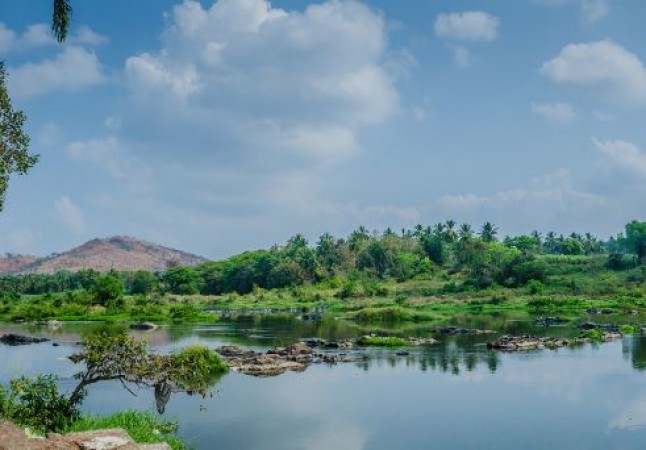
Srirangapatna, a small island town located in the Mandya, Karnataka, is a place of immense historical significance and natural beauty. Situated on the banks of the river Cauvery, Srirangapatna has been witness to numerous significant events and has played a crucial role in shaping the history and culture of South India.
The island was known as "Sringanapatana" in earlier records, referring to the "Sri Ranganatha Swamy Temple" dedicated to Lord Vishnu, which stands at the heart of the town. The temple's name later evolved into "Srirangapatna." The island's strategic location along the Cauvery River made it an important center for trade and culture in medieval South India.
Also Read: Where Eternal Beauty Meets Vibrant Energy is Mykonos
Srirangapatna's history became intertwined with that of the Vijayanagara Empire, one of the most powerful and prosperous empires of South India. The island served as a defensive outpost and played a pivotal role in guarding the northern borders of the empire. Under the Vijayanagara rule, Srirangapatna flourished as a significant religious and cultural center, attracting scholars, artists, and traders from various parts of the world.
In the early 16th century, the Vijayanagara Empire faced a severe setback due to the Battle of Talikota in 1565, leading to its decline. During this period, the Wodeyar dynasty rose to prominence and established their kingdom in Mysore, with Srirangapatna as their capital. The Wodeyars contributed to the island's development and built several significant structures, including the Daria Daulat Bagh (Summer Palace) and the Gumbaz (mausoleum of Tipu Sultan and his father Hyder Ali).
Also Read: Unknown Island of India
One of the most notable periods in Srirangapatna's history was during the reign of Tipu Sultan, the son of Hyder Ali. Tipu Sultan, often referred to as the "Tiger of Mysore," ascended to power in 1782 and continued the modernization and expansion efforts initiated by his father. He was a valiant warrior and a visionary ruler who sought to strengthen his kingdom and resist the British colonial ambitions.
Srirangapatna became the center stage for a series of conflicts between the British East India Company and Tipu Sultan's forces. The Anglo-Mysore Wars, particularly the two battles of Srirangapatna in 1799, had a significant impact on the history of the region. In the Fourth Anglo-Mysore War, Srirangapatna was besieged, and Tipu Sultan lost his life defending the island against the British forces.
Also Read: Hope Island: Shape of a Crescent Moon
Following Tipu Sultan's death, Srirangapatna came under British control. The British East India Company established its dominance in the region and made Mysore a princely state with Srirangapatna remaining an essential part of its administration. The British brought in various infrastructural changes, including the establishment of schools, hospitals, and modern administrative systems.
Srirangapatna's cultural heritage is a vibrant tapestry that reflects the influence of multiple dynasties and civilizations. The Sri Ranganatha Swamy Temple, dedicated to Lord Vishnu, is a significant religious site and an architectural masterpiece. The temple's intricate carvings, majestic gopurams (tower gateways), and beautiful sculptures showcase the rich artistic heritage of the region.
Also Read: Vallarpadam Island: Trading Hub of Civilization
The Daria Daulat Bagh, also known as the Summer Palace, is another prominent attraction in Srirangapatna. Built by Tipu Sultan, this Indo-Saracenic style palace exhibits exquisite frescoes depicting significant events from Tipu Sultan's life. The palace, surrounded by lush gardens, offers a glimpse into the opulence and grandeur of the bygone era.
The Gumbaz, located adjacent to the Daria Daulat Bagh, houses the tombs of Tipu Sultan, his father Hyder Ali, and other family members. The mausoleum is an architectural marvel, with massive domes, intricately designed walls, and elegant minarets.
Natural Beauty: Apart from its historical and cultural significance, Srirangapatna boasts breathtaking natural beauty. The island is surrounded by the Cauvery River, creating a serene and picturesque landscape. The lush greenery, coconut groves, and serene backwaters add to the island's charm, making it an ideal place for nature lovers and photographers.
Also Read: Tourists' Paradise in the Tropics: Krabi
Srirangapatna Island in Karnataka stands as a testament to India's rich history and cultural diversity. From being an integral part of the mighty Vijayanagara Empire to witnessing the rise and fall of powerful rulers like Tipu Sultan, the island has a fascinating past. Today, Srirangapatna continues to draw visitors from around the world with its historical landmarks, religious sanctuaries, and natural beauty, making it a must-visit destination for anyone eager to explore the splendor of South India's heritage.
Also Read: Exploring India's Geographical Marvels: From Himalayan Peaks to Coastal Plains